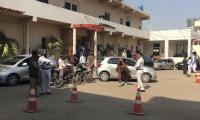On May 27, 2019, judges of the Supreme Court of Pakistan based in Islamabad heard cases of litigants from all over the country through videoconferencing. Although efficient videoconferencing technology has been widely available for more than 15 years now, this was the first time our Supreme Court made use of it. This little step forward by Chief Justice of Pakistan Asif Saeed Khosa must be appreciated. But, at the same time, I want to caution that in and of itself videoconfereing at the Supreme Court is not sufficient.
While Article 37(d) of the constitution promises inexpensive and expeditious justice to all citizens, for the most part, our judiciary honors this solemn promise only in the breach. Inordinate delay is normal, and efficiency is an exception. We can only chart out a path out of the abyss but first we must identify its cause in a scientific manner.
The accusation that ours is a delay-ridden judiciary does not come from outsiders only. According to a widely-quoted study conducted under the auspices of former chief justice Jawwad S Khawaja, the average time a civil case takes in Pakistan to be finally decided is 25 years. Most experience lawyers familiar with the ground realities would agree with that. What makes the issue more troubling is that it has been seen that judges too have a role in delaying the delivery of justice: the judges are known to adjourn hearings while exercising their judicial discretion.
In September 2014, I also had the opportunity to conduct a quantitative study to find out the causes behind the inordinate delays in the delivery of justice. At the time I was working as a research associate at the Supreme Court of Pakistan. I analyzed a representative sample of judicial orders to extract data on the reasons why judges exercise their discretion to adjourn the hearing of a case. I selected all cases from the docket of one randomly selected judge from May 2014 to February 2015. Here are a few of the astonishing findings.
First, the number of cases adjourned was huge. In one court alone, a total of 312 cases were adjourned from May 2014 to February 2015. Second, most of the adjournments were made upon the request of the lawyer of one of the parties. Out of 311 cases, 254 cases were adjourned only on the request of respondent’s lawyer without the consent of other party. Cases which got adjourned due to the non-availability of the bench were much fewer.
Third, I found that adjournments are far more frequently granted in civil case than in criminal cases. The number of criminal cases adjourned was 27 as compared to 297 civil cases. Fourth, the most common stated grounds for adjournment were medical. A total of 187 adjournments were granted on this basis alone. However, to my astonishment, lawyers were not required by judges to prove their claim about illness through a medical certificate. It may be noted that in other jurisdictions of the world, for instance in the United Kingdom, an application for adjournment on medical ground is required to be supported by a doctor’s medical certificate.
Finally, during the period under study, the famous dharna of the PTI also compelled the court to adjourn 22 times. Other frequently cited grounds for adjournment were: marriage of lawyer’s friend, ‘bad weather’ and so on. My study also revealed that the majority of cases adjourned pertained to property disputes (no wonder, property disputes in the country last several generations).
Based on the data collected, I would like to make three suggestions. First, the bar councils should bring their house in order. So, for example, the bar councils should take disciplinary action against every lawyer in the country who habitually remains absent from courts hearings. Lawyers are supposed to plead their clients’ case but obstructing justice, it should be remembered, is not within the job description of lawyers. In fact, to say the least, delaying court proceedings is a clear violation of the Canon of Profession Conduct of lawyers adopted by the bar councils. The council should enforce this code. Also, a maxim number of adjournment per case should be laid down and strictly enforced. If bar councils cannot put their own house in order, then parliament -- which created them in the first place -- should abolish them.
The Supreme Court also has an important role which it needs to play. Bear in mind that like all things in the legal universe, adjournments are governed by law -- and law requires interpretation. The Code of Civil Procedure 1908 empowers judges to adjourn a case only on ‘reasonable ground’ but it does not list down what is and is not a “reasonable ground”. So, for instance, is 'attending a friend’s wedding' a sufficient ground? What about a 'lawyer’s strike'? The CPC also does not tell us what sort of evidence is required to establish reasonable ground for adjournment. Is a medical certificate necessary?
In the Petition for Defeating Delays, Umer Gliani and other lawyers had urged the Supreme Court to answer these questions and to re-interpret the law on adjournments. Unfortunately, their plea fell upon deaf ears. The point they made is worth repeating. Judges of the Supreme Court may not have the magic wand needed for overhauling the judicial system, but they do have one, powerful tool which can be used to reduce delays: interpretation.
And the last but not the least important tool for delivery of inexpensive and expeditious justice is the one which I mentioned at the beginning of this article: new modern technologies. Videoconferencing must be used as often as possible to bridge the miles of distance between litigants, lawyers, witnesses and judges. It can help discourage the menace of adjournments as rightly hoped by the chief justice of Pakistan during the first proceeding of the e-court.
The writer is a Quetta-based lawyer. Email: raliquetta@gmail.com
We are haunted by systemic inefficiencies that threaten to dismantle this fragile ascent
Misinformation runs rampant, webbed into political rhetoric, social commentaries, viral posts, and group chats
Difference lies in institutions governing these regions, SK and Arizona built inclusive institutions, while their...
At heart of our problems is misalignment of our efforts with our objectives
Studies have established that most effective interventions for improving quality of education is to train teachers
For Pakistan, 2025 must be year of decisive action and vision







